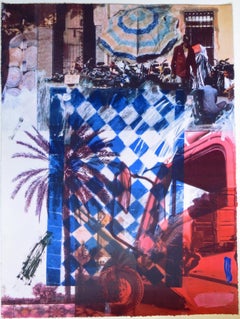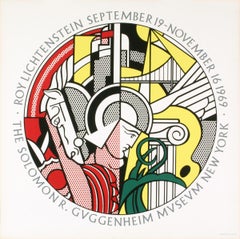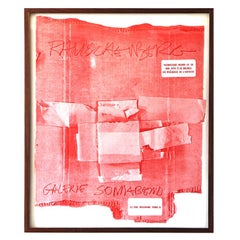Darryl Pottorf Abstract Prints
to
1
Overall Width
to
Overall Height
to
1
1
636
206
165
163
1
1
1
1
Artist: Darryl Pottorf
Darryl Pottorf Exceptional Print – Truck Stop de Marra Kech
By Darryl Pottorf
Located in San Francisco, CA
This impressive 12 color screenprint is by Darryl Pottorf (1952- ) The print is titled “Truck Stop de Marra Kech”. It was printed and published in 2000 by Gemini G.E.L. the well-kno...
Category
Early 2000s Pop Art Darryl Pottorf Abstract Prints
Materials
Screen
Related Items
Roy Lichtenstein -Guggenheim Museum-1969 Serigraph Pop Art
By Roy Lichtenstein
Located in Brooklyn, NY
This original poster, designed by Roy Lichtenstein for his first solo exhibition at the Guggenheim Museum in New York (September 19–November 16, 1969), is a screen print on white glo...
Category
1960s Pop Art Darryl Pottorf Abstract Prints
Materials
Screen
$600 Sale Price
20% Off
H 28.75 in W 28.75 in D 0.1 in
Cardbirds, 1972 exhibition, rare original red poster, Robert RAUSCHENBERG
By Robert Rauschenberg
Located in Brooklyn, NY
Robert RAUSCHENBERG
Cardbirds, 1972 exhibition, rare original poster
For the exhibition "Cardbirds" at the Sonnabend Gallery
Signed in the plate framed in walnut.
21 x26.5" framed.
...
Category
1970s Pop Art Darryl Pottorf Abstract Prints
Materials
Screen
$1,000 Sale Price
60% Off
H 26 in W 21 in
Modern Print /// Roy Lichtenstein Pop Art Abstract Geometric MoMA Gemini G.E.L.
By Roy Lichtenstein
Located in Saint Augustine, FL
Artist: Roy Lichtenstein (American, 1923-1997)
Title: "Modern Print"
*Numbered, signed, and dated by Lichtenstein in pencil lower right
Year: 1971
Medium: Original Lithograph and Scr...
Category
1970s Pop Art Darryl Pottorf Abstract Prints
Materials
Lithograph, Screen
'America: The Third Century' 1976- Serigraph
Located in Brooklyn, NY
This serigraph poster by Allan D'Arcangelo was created in 1976 to commemorate the American Bicentennial, celebrating 200 years of the nation's in...
Category
1970s Pop Art Darryl Pottorf Abstract Prints
Materials
Screen
Steve Kaufman "Abraham Lincoln" 1990 Artist Proof Serigraph, Hand Signed Verso
By Steve Kaufman
Located in Miami, FL
STEVE KAUFMAN – "ABRAHAM LINCOLN"
⚜ Serigraph on Canvas ⚜ Initialed Verso ⚜ Edition 48/50 AP ⚜ Black Float Frame
VIBRANT POP ICONOGRAPHY OF AN AMERICAN LEGEND
This bold 1990 serigra...
Category
1990s Pop Art Darryl Pottorf Abstract Prints
Materials
Screen, Canvas
$2,400 Sale Price
25% Off
H 19.5 in W 15.125 in D 2 in
Hero as a Riddle by Eduardo Paolozzi gold silver pop art with Basquiat style
By Eduardo Paolozzi
Located in New York, NY
Hero as a Riddle (1963) depicts a smiling head printed in gold, silver, and black. The shapes and lines composing the figure’s face are architectural and geometric: the eyes are comp...
Category
1960s Pop Art Darryl Pottorf Abstract Prints
Materials
Screen
$2,650
H 39.5 in W 29.5 in
LOVE (Plate 4) /// Pop Art Robert Indiana Screenprint Post-War New York Minimal
By Robert Indiana
Located in Saint Augustine, FL
Artist: Robert Indiana (American, 1928-2018)
Title: "LOVE (Plate 4)"
Portfolio: Book of Love
*Signed and dated by Indiana in pencil lower right
Year: 1996
Medium: Original Screenprint on A.N.W. Crestwood Museum Edition paper
Limited edition: 75/200, (there were also 50 impressions in roman numerals)
Printer: Freeman Burks of American Image Editions, New York, NY
Publisher: Michael McKenzie of American Image Editions, New York, NY
Framing: Framed in a contemporary silver moulding and silver filet with white cotton rag matting
Framed size: 32.13" x 30.63"
Sheet size: 24" x 20"
Image size: 18.19" x 18"
Condition: Minor cosmetic wear to frame. In excellent condition
Notes:
Provenance: private collection - Cincinnati, OH. Numbered by Indiana in pencil lower left. Comes from Indiana's 1996 "Book of Love" portfolio of twelve screenprints of the same image in various colors, originally issued in a black-lettered brown paper-covered folio with accompanying twelve poems. Besides the Arabic and Roman numeral editions, there were also 15 artist's proofs. Technical Director: Peter Engert; Plate Maker: James Harvey; Counsel: Gregory S. Smith, Esq.; Fabricator: Al Hirshson; and Die Maker: York Display. Printed in three colors: white, gray, and dark gray.
The "Book of Love" project was conceived by the artist as a portfolio that would make a definitive statement on his masterpiece "LOVE", fulfilling his original vision as both a poet and a painter. The prints in the portfolio were created by Indiana as illustrations for his own love poems, written circa 1958-1973. The prints were produced in silkscreen using oil based paints on a newly created fine art paper that he found perfect for rendering "LOVE", which demands a precise line and radiant true color. The poems each have a highly raised embossment of "LOVE", trapped in colors, just below the title. Each print is hand pencil signed, and each poem hand pencil initialed by the artist.
Biography:
Robert Indiana was born on September 13, 1928 named Robert Clark in New Castle...
Category
1990s Pop Art Darryl Pottorf Abstract Prints
Materials
Screen
$10,000 Sale Price
28% Off
H 32.13 in W 30.63 in
Sajippe Kraka Joujesh
By Kenny Scharf
Located in Hollywood, FL
Artist: Kenny Scharf
Title: Sajippe Kraka Joujesh
Medium: Silkscreen
Signed: Hand Signed
Measurements: 39" x 46"
Edition Number: 26/150
PRINTER: Fine Art Printing Ltd, NYC
PUBLIS...
Category
1990s Pop Art Darryl Pottorf Abstract Prints
Materials
Screen
Youngerman-Amnesty International Hand Signed
By Jack Youngerman
Located in Brooklyn, NY
First edition serigraph created and designed by Jack Youngerman for Amnesty International in 1977. Signed in pencil by Youngerman. Artists for Amnesty, a series of art posters create...
Category
1970s Pop Art Darryl Pottorf Abstract Prints
Materials
Screen
The Calumet /// Pop Art Robert Indiana Native American Indiana Screenprint Red
By Robert Indiana
Located in Saint Augustine, FL
Artist: Robert Indiana (American, 1928-2018)
Title: "The Calumet"
Portfolio: The American Dream
*Issued unsigned
Year: 1997
Medium: Original Screenprint on Coventry paper
Limited edition: 395, (there were also 30 artist's proofs)
Printer: Marco Fine Arts Contemporary Atelier, El Segundo, CA
Publisher: Marco Fine Arts Contemporary Atelier, El Segundo, CA
Sheet size: 22" x 16.75"
Image size: 15.07" x 14"
Condition: In excellent condition
Notes:
Provenance: private collection - Düsseldorf, Germany. Comes from Indiana's 1997 "The American Dream" book portfolio of thirty screenprints. Printed in three colors. Text on verso of the following work as issued.
Robert Indiana's 1997 black leather-covered book portfolio "The American Dream" was printed and published with 30 screenprints: 6 loose each signed and numbered and 24 bound not signed and numbered, as issued. Forward by Susan Ryan, text by Michael McKenzie and poems by Robert Creeley. The book was issued within a white cardboard packing box with red and black lettering.
This image is based of Indiana's 1971 screenprint edition "The Calumet", (Sheehan No. 64, page 43), from his 1971 "Decade" series, (Sheehan No. 63-72, page 42-44). The prints in that portfolio reproduce one of Indiana's paintings from each year of the 1960's. The bear they same titles as the corresponding paintings. "The Calumet" is a 1961, 90" x 84", oil on canvas painting which is within the permanent collection of the Rose Art Museum, Brandeis University, Waltham, MA.
"The Calumet", derived from Longfellow's "Song of Hiawatha", reflects Indiana's ongoing involvement with American literary associations and sources. As interpreted, by Indiana, the schematized image of the red clay peace-pipe smoked by the Indians in Longfellow's poem symbolizes mankind's potential to eradicate war. - (Sheehan page 9). Seven stars for seven spheres...
Category
1990s Pop Art Darryl Pottorf Abstract Prints
Materials
Screen
Archipiélago dinámico
By Luis Gordillo
Located in Mexico City, MX
The work of Luis Gordillo spans more than five decades. He began his career by developing a new pictorial language that became a point of reference for an entire generation of artist...
Category
20th Century Pop Art Darryl Pottorf Abstract Prints
Materials
Screen
"Nobility" 180/300 Signed Color Serigraph of Abstract Horse and Woman with Lute
By Tiefeng Jiang
Located in Austin, TX
Serigraph on paper
Page Size: 12 x 12 in.
Gold Leaf Frame Size: 21 x 21 in.
Hand Signed, bottom right in black marker
Hand Numbered, bottom left in black marker "180/300"
This strik...
Category
1990s Pop Art Darryl Pottorf Abstract Prints
Materials
Archival Paper, Screen
Darryl Pottorf abstract prints for sale on 1stDibs.
Find a wide variety of authentic Darryl Pottorf abstract prints available for sale on 1stDibs. If you’re browsing the collection of abstract prints to introduce a pop of color in a neutral corner of your living room or bedroom, you can find work that includes elements of purple and other colors. You can also browse by medium to find art by Darryl Pottorf in screen print and more. Much of the original work by this artist or collective was created during the 21st century and contemporary and is mostly associated with the Pop Art style. Not every interior allows for large Darryl Pottorf abstract prints, so small editions measuring 27 inches across are available. Customers who are interested in this artist might also find the work of Donald Baechler, Luis Gordillo , and Michael Knigin. Darryl Pottorf abstract prints prices can differ depending upon medium, time period and other attributes. On 1stDibs, the price for these items starts at $2,500 and tops out at $2,500, while the average work can sell for $2,500.


